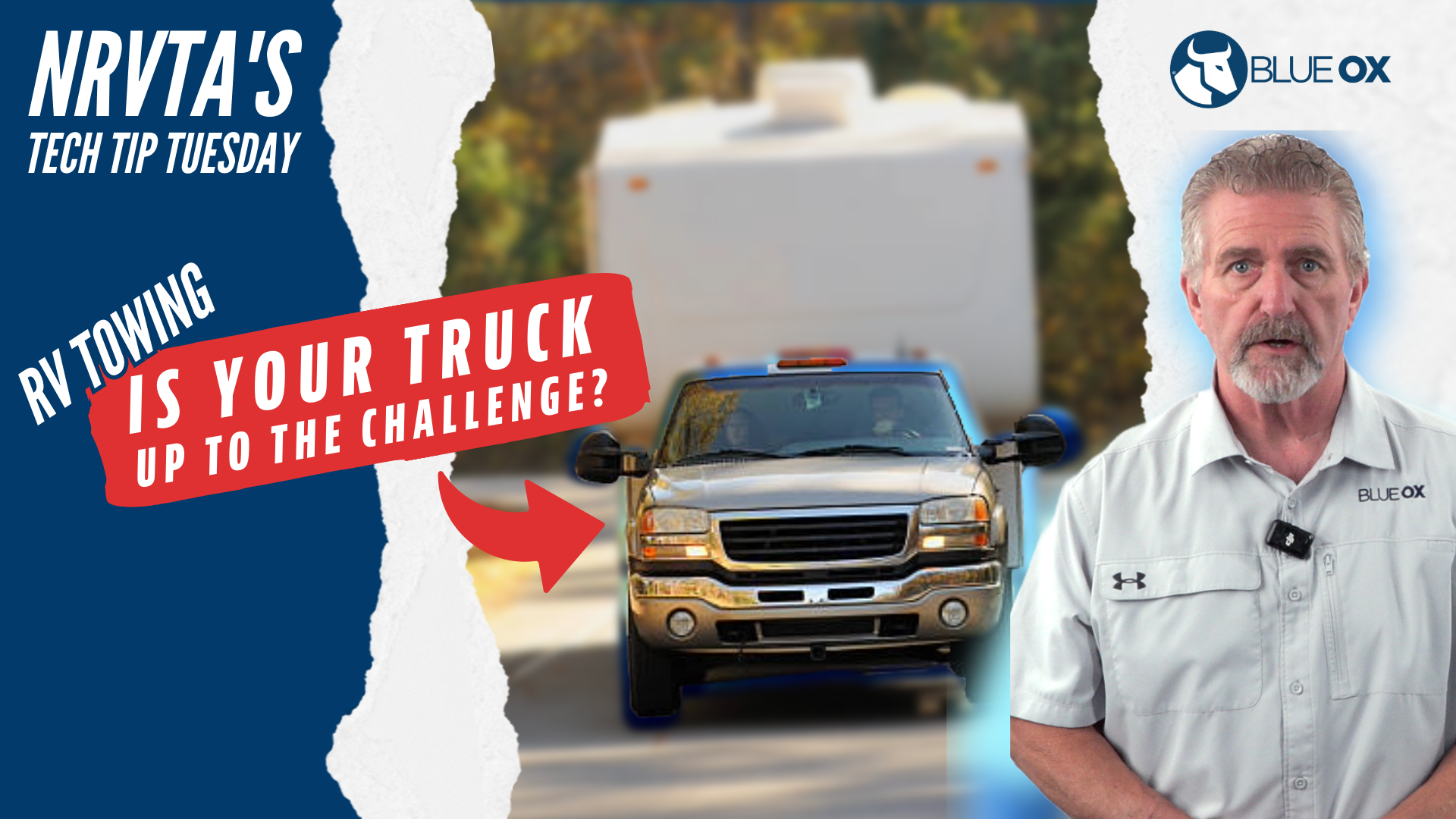Get your RV Technician Certification in as little as 5 weeks!

Towing your RV should be a smooth and enjoyable experience—not a stressful ride that leaves you gripping the steering wheel and holding your breath. Whether you’re a seasoned RVer or just getting started, understanding tow capacity, weight distribution, and proper setup is key to towing safely and confidently. In this week’s Two-Minute Tech Tip Tuesday, we dive into the details of matching your travel trailer to the right tow vehicle
Presented by the National RV Training Academy, the largest hands-on RV training school in America.
Why Truck and Trailer Matching Matters
RV manufacturers are building travel trailers that are longer, wider, and heavier than ever before. While that means more space and comfort, it also means more stress on your tow vehicle. Many RVers get into trouble by selecting the wrong truck—or by overloading the one they have.
That’s why the order of your purchase matters. It’s better to choose your trailer first, and then find the truck that can safely tow it. Falling in love with a trailer that your current vehicle can’t handle often leads to disappointment—or a costly upgrade.
The Tow Capacity Myth
Truck advertisements love to highlight their “max tow capacity” numbers—12,000, 13,000, even 14,000 pounds. But those numbers are often based on specific, ideal configurations that aren’t typically sold at dealerships.
Here’s what really impacts your truck’s towing capacity:
- Engine size
- Transmission type
- Drive (2WD vs. 4WD)
- Cab size and bed length
- Gear ratio
- Axle configuration
One change in any of these can drastically alter the tow rating.
80% Rule: The Smart Towing Threshold
At Blue Ox, we recommend towing no more than 80% of your vehicle’s max capacity when fully loaded. For example, if your truck has a tow rating of 10,000 lbs, you should aim for no more than 8,000 lbs of loaded trailer weight.
This gives you a margin of safety for braking distance, engine strain, tire wear, and frame integrity.
Understand GVWR, Payload, and GCWR
- GVWR (Gross Vehicle Weight Rating) is the max weight of your trailer, including cargo, water, and gear.
- Payload is how much weight your truck can carry in the cab and bed (including passengers and cargo).
- GCWR (Gross Combined Vehicle Weight Rating) is the total max weight of your truck and trailer together.
If you exceed any of these, you’re not just risking performance issues—you’re risking safety.
The Importance of Weight Distribution
Regardless of whether you have a ½-ton, ¾-ton, or 1-ton truck, a weight distribution hitch is essential. Without it, you’re placing too much stress on the rear receiver hitch and decreasing front-wheel traction.
Blue Ox’s SwayPro and TrackPro hitch systems help:
- Distribute trailer tongue weight more evenly
- Improve steering and braking control
- Minimize sway during highway speeds
The result? A smoother, safer towing experience.
Real-World Example
One customer with a half-ton truck and a toy hauler was experiencing serious sway and poor control. The issue? His trailer tongue weight exceeded 2,000 lbs—and he had a massive Snap-On toolbox in the bed of his truck directly over the hitch.
The solution was twofold:
- Redistribute the weight (move gear toward the front of the truck bed)
- Consider upgrading the hitch or truck
When loading your pickup bed, never stack heavy gear directly over the hitch. That added stress can push you over your limit quickly.
Brake Control Matters
Proper stopping power is just as important as power to tow. Most modern trucks include integrated brake controllers, but they still need to be set up correctly. Start at a lower setting and adjust based on your trailer’s response. In an emergency stop, you want your brakes to respond quickly and evenly—not with a delay that doubles your stopping distance.
Summary: Smart Towing Tips
- Choose your trailer first, then match it with a truck
- Follow the 80% rule for safe towing
- Understand your GVWR, GCWR, and payload limits
- Use a weight distribution hitch like Blue Ox SwayPro or TrackPro
- Avoid overloading your truck bed or hitch area
- Learn and properly set your brake controller
- Research your truck’s specs—know the engine, transmission, gear ratio, and suspension
The Bottom Line
Towing an RV doesn’t have to be a guessing game. With the right tools, setup, and education, you’ll enjoy a smoother ride, better safety, and less wear on your equipment. Start by understanding your limits—and then stay within them.
To learn more about weight distribution hitches and safe towing practices, visit blueox.com.
And if you’re serious about becoming a confident RVer or certified technician, check out hands-on training opportunities at the National RV Training Academy.
There’s your Tech Tip.
Get Registered Today!
Talk to a student advisor to learn more!